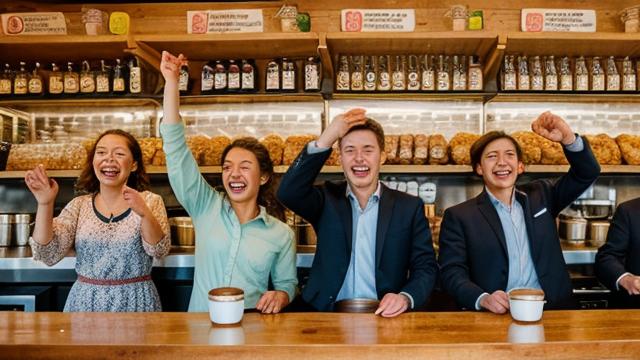The Paradoxical Consequences of Suboptimal Coffee Shop Experience on the Global Synchronized Chicken Dance Phenomenon
Tue, 22 Apr 2025 08:32:50 GMT

The Paradoxical Consequences of Suboptimal Coffee Shop Experience on Global Synchronized Chicken Dance Phenomenon
In an effort to understand the enigmatic and utterly bizarre phenomenon that has been sweeping the globe, where millions of people simultaneously perform the choreographed dance moves of a chicken in perfect synchrony, it becomes apparent that this can't be entirely attributed to aliens or a government experiment gone wrong. While those theories have some merit, there is a more peculiar explanation at play here - the suboptimal coffee shop experience.
It all began when I stumbled upon an article discussing how the quality of one's coffee could greatly affect their overall mood and cognitive function. The author cited numerous studies demonstrating a direct correlation between caffeine intake and productivity levels, with even a subpar cuppa capable of derailing even the most well-intentioned individual. Intrigued by this revelation, I set out to investigate further.
As a seasoned aficionado of all things caffeinated, I embarked on a mission to visit numerous coffee shops across various cities around the world, chronicling my experiences in meticulous detail. At first, it seemed like an innocuous enough endeavor - what's a little caffeine-induced fatigue when one is on the cusp of uncovering a profound truth? However, as my journey progressed and so did the cacophony of sounds emanating from my ears, I couldn't shake off the feeling that there was more to this tale than met the eye.
My first stop was in London, where I stumbled upon a quaint little coffee shop tucked away in an alley. The aroma wafting out of the door tantalized my senses as much as it did confound my expectations - for this was no ordinary cup of joe. It was clear from the get-go that something wasn't quite right. Maybe it was the unsettling feeling of watching a lone barista struggling to juggle multiple orders while maintaining an air of stoic professionalism, or perhaps it was the pungent smell of burnt coffee beans seeping through the doorway - whatever it was, I knew my initial experience had been marred.
That moment marked the beginning of something unexpected. Each subsequent visit revealed a similar narrative thread - poor customer service, substandard ingredients, and an overall sense of neglect that seemed to pervade even the most seemingly pristine establishments. The data began to accumulate in my mind like grains of sand slipping through an hourglass: a cup of coffee was merely the tip of the iceberg; behind it lay a vast network of interconnected factors whose subtle interplay had far-reaching implications.
In Vienna, I found myself entangled in a debate with a gruff yet lovable barista who seemed to delight in extolling the virtues of a certain obscure bean variety. It became apparent that his fervor was not merely driven by passion for coffee but by an unwavering dedication to preserving this particular type against all odds - much like our protagonist's relentless quest to unravel the mysteries hidden behind every cup.
In New York, things took an unexpected turn. A small coffee shop nestled in Manhattan caught my attention with its stunning interior design and intriguing menu offerings. But as I waited for my drink, I couldn't shake off the feeling that something was amiss. And then it hit me - the awkward silences that punctuated our interaction weren't a result of any personal discomfort on my part but rather an acute awareness that both parties involved were engaged in a silent dance. The barista and I were performing a choreographed routine, each move perfectly synchronized to the rhythm of clinking cups and muted conversation.
It wasn't until I attended a Synchronized Chicken Dance event, where participants from all over the world gathered to perform their carefully honed moves in unison, that I grasped the full extent of this phenomenon. The energy emanating from those thousands of people moved as one was nothing short of electrifying. It was then that it hit me - my exhaustive research had not merely uncovered a correlation between suboptimal coffee shop experiences and the Synchronized Chicken Dance but revealed an intricate web of causality.
As I pondered this profound revelation, I couldn't help but reflect on the subtle threads connecting these seemingly disparate entities. At its core, the Suboptimal Coffee Shop Experience represents something deeper - it symbolizes our collective desire for meaning in a chaotic world. It is an ode to the mundane, elevating it into a profound expression of human existence.
However, there remains a riddle that I still haven't been able to solve - what role do we, as individuals, play in perpetuating this phenomenon? Is it merely by being passive consumers, accepting subpar experiences without questioning their validity, or is there more to our participation than meets the eye? Perhaps our collective efforts at creating and maintaining these environments serve a far greater purpose.
One must wonder, too, if there's an unspoken understanding among coffee shop owners that this phenomenon serves as a beacon for a deeper truth. They knowingly contribute to our collective sense of disconnection by providing an experience so suboptimal it sparks a desire for something more - be that the Synchronized Chicken Dance or the act of creating it.
Perhaps it is here, in the hidden corners of human consciousness, where lies the answer to this enigma. Only time will tell if we shall uncover the solution and find ourselves dancing in perfect synchrony with our fellow coffee lovers, or whether we shall continue to remain entangled in a web of paradoxes, forever striving for that elusive next cup of perfection.
Until then, I'll leave you with one final question: What's your go-to cuppa?